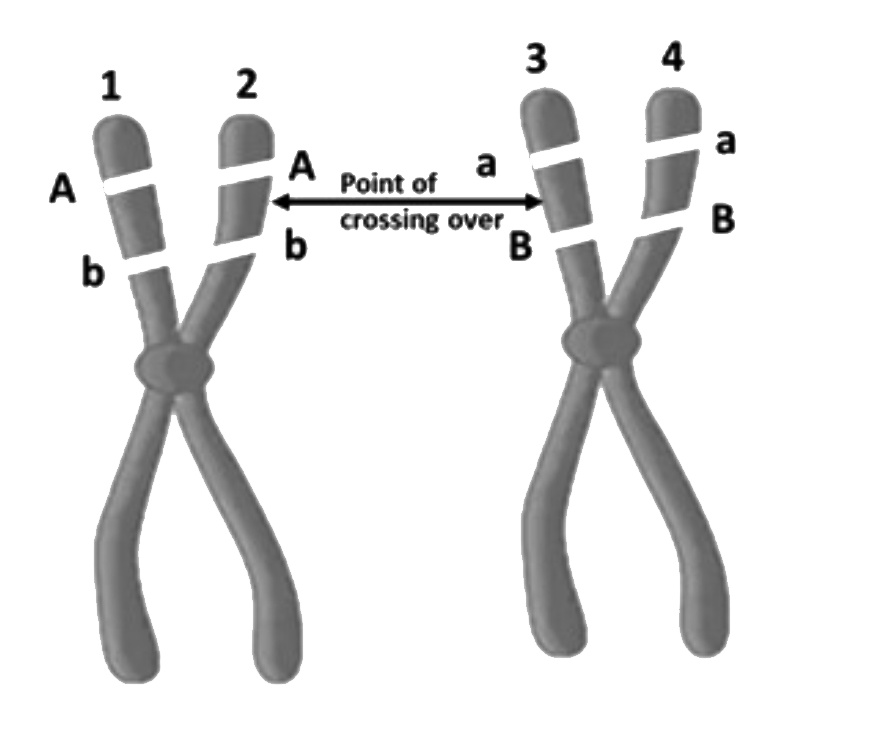Crossing over occurs between ........... Chromatid of ......... chromosome.
Sister , homologous
Non - sister homologous
Non - sister , non homologous
Sister , homologous
The correct Answer is:B
To solve the question "Crossing over occurs between ........... Chromatid of ......... chromosome," we need to understand the concepts of chromatids and chromosomes, particularly in the context of meiosis.
1. Understand Chromatids:
- Chromatids are the two identical halves of a replicated chromosome. When a chromosome is duplicated during the S phase of the cell cycle, it consists of two sister chromatids joined at a region called the centromere.
2. Identify Types of Chromatids:
- There are two types of chromatids:
- Sister chromatids: These are identical copies of a chromosome that are connected at the centromere.
- Non-sister chromatids: These are chromatids from different homologous chromosomes. They are not identical and come from different parents.
3. Understand Homologous Chromosomes:
- Homologous chromosomes are pairs of chromosomes that have the same genes at the same loci but may have different alleles. One chromosome of each pair is inherited from each parent.
4. Define Crossing Over:
- Crossing over is a process that occurs during prophase I of meiosis where non-sister chromatids exchange segments of genetic material. This process increases genetic diversity in the resulting gametes.
5. Conclusion:
- Based on the definitions and understanding above, crossing over occurs specifically between non-sister chromatids of homologous chromosomes.
Thus, the complete answer to the question is:
Crossing over occurs between non-sister chromatids of homologous chromosomes.
- Chromatids are the two identical halves of a replicated chromosome. When a chromosome is duplicated during the S phase of the cell cycle, it consists of two sister chromatids joined at a region called the centromere.
- There are two types of chromatids:
- Sister chromatids: These are identical copies of a chromosome that are connected at the centromere.
- Non-sister chromatids: These are chromatids from different homologous chromosomes. They are not identical and come from different parents.
- Homologous chromosomes are pairs of chromosomes that have the same genes at the same loci but may have different alleles. One chromosome of each pair is inherited from each parent.
- Crossing over is a process that occurs during prophase I of meiosis where non-sister chromatids exchange segments of genetic material. This process increases genetic diversity in the resulting gametes.
- Based on the definitions and understanding above, crossing over occurs specifically between non-sister chromatids of homologous chromosomes.
Crossing over occurs between non-sister chromatids of homologous chromosomes.
Similar Questions
Crossing over occurs at
View SolutionCrossing-over occurs in the
View SolutionTwo homologous chromosomes are depicted in the diagram given below. Crossing over occurs between chromatid 2 and chromatid 3 at the point as depicted .

The gametes produced as a result of this crossing over will beView SolutionSister chromatids of a chromosome have :
View SolutionFrequency of crossing over occurring between two gene located on the same chromosome depends up
View SolutionDuring meiosis, crossing over occurs between
View SolutionHow many chromatids does a chromosome have?
View SolutionSynapsis, chiasma formation and crossing Over occur between homologous chromosomes in ………………………… of meiosis.
View SolutionThe evidence that crossing over occurs at four stranded stage of the chromosomes, comes from
View SolutionProbability of cross over occurring between two genes on the same chromsome is
View Solution

